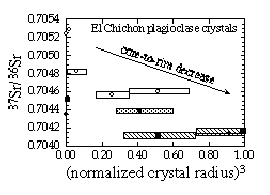
Distinguishing the isotopic characteristics of mantle sources from those inherited during open system differentiation is a major concern in igneous geochemistry. Correlations between isotope ratios and indices of differentiation provide arguably the only unequivocal evidence for the influence of open system processing in the crust (contamination, magma mixing, afc) on isotope compositions. Yet such correlations may be rarely preserved, and depend on a simple differentiation history.
Variations of radiogenic isotope ratios in single phenocrysts from volcanic rocks provide an alternative means of identifying open system behavior. As phenocrysts grow they record the instantaneous isotope composition of the magma from which they are precipitated - both in the crystal lattice and in any melt inclusions trapped at that stage. If the isotope ratio of the magma changes, so will the isotope ratio of the crystal growth layer in equilibrium with that magma, generating a core-rim stratigraphy in isotope composition. If the nature of the phenocryst - for instance plagioclase - indicates growth under crustal (rather than mantle) pressures and temperatures, then isotope modification is clearly occurring in the crust. Diffusional equilibration is precluded by the relatively short growth time scales in most magma systems, and effective closure to diffusion on eruption.
We have examined 87Sr/86Sr ratios in a number of plagioclase crystals from young volcanic systems, using a micro-drilling technique followed by chemical separation of Sr and high precision/sensitivity mass spectrometry. Three crystals from the El Chichon (Mexico) 1982 deposit show decreasing 87Sr/86Sr from core-to-rim (Fig. 1). Core 87Sr/86Sr ratios are considerably higher than those reported for bulk lavas. Core-rim variations may be correlated with the observed complex oscillatory zoning of the crystals (McGee et al., 1987), and may reflect recharge of a contaminated system by a lower 87Sr/86Sr mafic magma.
Similar studies of plagioclase crystals in mafic inclusions of Chaos Crags (Lassen Volcanic National Park, CA), and Purico Chascon (N. Chile) show core-rim differences, with lower 87Sr/86Sr at the rim. At Lassen, the core compositions are similar to those of the host dacite, and the lower rim 87Sr/86Sr is believed to reflect equilibration with the magma of the mafic inclusions. At Purico Chascon the core 87Sr/86Sr is even higher than the host dacite, suggesting that the dacite is itself a hybrid of low 87Sr/86Sr mafic magma and an even higher 87Sr/86Sr component. Thus crystal isotope stratigraphy enables us to examine the inheritance of components involved in the magma mingling process that produced the inclusion-bearing dacites.
McGee, J.J., Tilling, R.I. & Duffield, W.A., Geof. Int. 26, 85-108 (1987).
Fig. 1: Isotope zoning in three separate plagioclase crystals from the 1982 El Chichon eruption. Crystals are between 3 and 5mm in length, but dimensions are normalized for comparison, and cubed to represent mass balance of Sr. Drill sites are plotted relative to crystal center (0.0) and edge (1.0), and horizontal box represents width of drill hole.